Pasta Recipes
Oxtail Pasta Recipe: Rich, Hearty, and Comforting
Oxtail pasta is a rich, savory dish that brings together the deep flavors of slow-cooked meat with the comforting allure of pasta. If you’re seeking a meal that’s hearty, full of complex textures, and utterly satisfying, look no further. This recipe combines tender oxtail, aromatic vegetables, robust herbs, and perfectly cooked pasta to create a meal worth savoring. Below, we will walk you through each step to create this delightful dish in your own kitchen.
Ingredients for the Perfect Oxtail Pasta
Before we dive into the cooking process, it’s essential to gather all your ingredients. To create an oxtail pasta that bursts with flavor, you’ll need the following:
- Oxtail (1.5 to 2 pounds): The star of the dish, oxtail provides a succulent, tender meat that becomes more flavorful the longer it cooks.
- Pasta (400g): Opt for pappardelle, rigatoni, or tagliatelle as they pair well with thick, hearty sauces.
- Onions (2 medium-sized, finely chopped): They add a subtle sweetness and depth to the dish.
- Carrots (2, diced): Essential for building the base flavor of the sauce.
- Celery (2 stalks, chopped): Adds freshness and balances the richness of the oxtail.
- Garlic (4 cloves, minced): Garlic infuses the sauce with warmth and intensity.
- Tomato paste (2 tablespoons): It thickens the sauce and gives it a rich, tangy flavor.
- Crushed tomatoes (1 can, 28 ounces): Helps form the base of the sauce.
- Red wine (1 cup): Deepens the flavor and tenderizes the oxtail.
- Beef broth (4 cups): Ensures the oxtail stays moist throughout the cooking process.
- Bay leaves (2): Adds a subtle earthy flavor.
- Fresh rosemary and thyme (2 sprigs each): These herbs enhance the aroma and taste of the sauce.
- Olive oil (2 tablespoons): For searing the oxtail and sautéing vegetables.
- Salt and pepper to taste
- Freshly grated Parmesan (optional for garnish)
Step-by-Step Guide to Making Oxtail Pasta
1. Preparing the Oxtail
To begin, you’ll want to sear the oxtail. Heating olive oil in a large pot over medium-high heat, season the oxtail pieces generously with salt and pepper. Once the oil is shimmering, carefully add the oxtail and sear on all sides. This process locks in the juices and creates a beautiful caramelized exterior, which will contribute to the flavor of the sauce later on. Sear for about 4-5 minutes per side, then remove the oxtail and set it aside.
2. Building the Sauce Base
Using the same pot with the flavorful brown bits left behind from the oxtail, add the chopped onions, carrots, celery, and garlic. Cook these vegetables over medium heat until they soften and begin to brown slightly—about 8-10 minutes. Stir in the tomato paste and let it cook for another 2 minutes to enhance its richness.
3. Deglazing with Red Wine
Pour in the red wine to deglaze the pot, scraping up all the delicious bits stuck to the bottom. Let the wine simmer for about 5 minutes, allowing the alcohol to cook off and the liquid to reduce slightly.
4. Adding Tomatoes and Broth
Next, stir in the crushed tomatoes, beef broth, bay leaves, rosemary, and thyme. Bring the mixture to a boil, then reduce the heat to low. Return the seared oxtail to the pot, making sure it’s submerged in the sauce.
5. Simmering for Tenderness
Cover the pot and let the oxtail simmer for at least 3 hours, occasionally stirring to ensure the meat doesn’t stick. The long, slow cooking process will break down the oxtail’s tough connective tissues, making the meat tender and fall-off-the-bone soft. After 3 hours, check if the meat is tender enough to shred. If not, continue cooking for another 30 minutes to an hour.
6. Shredding the Oxtail
Once the oxtail is thoroughly cooked, remove it from the pot and set it aside to cool slightly. Shred the meat, discarding any bones and excess fat. Return the shredded meat to the sauce, stirring to combine and let the flavors meld together for an additional 15 minutes.
Cooking the Pasta and Combining the Dish
1. Cooking the Pasta
While the oxtail finishes its final simmer, bring a large pot of salted water to a boil. Add your pasta and cook it according to the package instructions, usually 8-10 minutes for al dente. Drain the pasta, but reserve about a cup of the pasta water.
2. Tossing the Pasta with Oxtail Sauce
Add the drained pasta directly to the pot with the oxtail sauce, gently tossing to combine. If the sauce is too thick, add a splash of the reserved pasta water to loosen it up. The starch in the pasta water will help the sauce cling to the noodles, creating a perfectly coated dish.
Serving and Garnishing the Oxtail Pasta
When you’re ready to serve, plate the oxtail pasta generously. Top with freshly grated Parmesan, if desired, and garnish with a sprig of fresh rosemary or thyme for an extra aromatic touch. For the best experience, serve this meal alongside a robust red wine, such as a Cabernet Sauvignon or a Sangiovese, to complement the rich flavors of the dish.
Tips for the Best Oxtail Pasta
1. Use Quality Oxtail
High-quality oxtail is essential for achieving the best flavor. Look for well-marbled pieces, as the fat content will render down and infuse the sauce with a deep, savory taste.
2. Slow Cooking is Key
Patience is critical when making oxtail pasta. The longer the oxtail simmers, the more tender and flavorful the meat becomes. If you’re short on time, this recipe can be adapted for a slow cooker or pressure cooker, but traditional simmering on the stovetop yields the best results.
3. Pasta Choice Matters
Choosing the right pasta is crucial. Larger, flatter noodles like pappardelle or tagliatelle are ideal because they can hold up to the thick, meaty sauce. Avoid delicate or thin pastas, which may become overwhelmed by the richness of the dish.
4. Balance with Acidity
Oxtail pasta can be quite rich, so balancing the flavors with acidity is important. Adding a splash of vinegar or a squeeze of lemon juice right before serving can brighten the sauce and cut through the heaviness of the meat.
Storing and Reheating Oxtail Pasta
Oxtail pasta stores well and, in fact, often tastes better the next day as the flavors have more time to meld together. To store, place leftovers in an airtight container and refrigerate for up to 3 days. To reheat, warm the pasta on the stovetop over low heat, adding a little beef broth or water to loosen the sauce as needed.
Read More : Zero Carb Pasta Recipe: Delicious Without the Guilt
Faq’s
1. What is oxtail, and where can I buy it?
Oxtail is the tail of a cow, known for its rich, gelatinous meat and deep flavor when slow-cooked. You can find it at most butcher shops, specialty meat stores, or well-stocked supermarkets, usually in the fresh or frozen meat section.
2. Can I use a different cut of meat instead of oxtail?
While oxtail gives this dish its unique, deep flavor, you can substitute it with other slow-cooking meats like short ribs or beef shank. However, you might lose some of the distinct richness that oxtail provides.
3. What type of pasta pairs best with oxtail sauce?
Thicker pasta varieties, such as pappardelle, tagliatelle, or rigatoni, work best. These pastas can hold up to the hearty, rich sauce and absorb the flavors well.
4. How long does it take to cook oxtail pasta?
It takes approximately 3 to 4 hours to cook the oxtail until tender, but this slow process is essential for achieving the best results. Including prep and pasta cooking time, you’ll need about 4 to 5 hours in total.
5. Can I make oxtail pasta in a slow cooker?
Yes! After searing the oxtail and sautéing the vegetables, you can transfer everything to a slow cooker and cook on low for 8 hours or on high for 5 hours. This method still yields tender, flavorful results.
6. Can I freeze oxtail pasta?
Absolutely! Oxtail pasta freezes well. Store it in an airtight container for up to 3 months. To reheat, thaw it overnight in the fridge and warm it on the stovetop, adding a bit of broth or water if needed to loosen the sauce.
7. How can I make the dish less rich?
To balance the richness of the oxtail, you can add a splash of red wine vinegar or lemon juice at the end of cooking. This acidity helps cut through the heaviness of the sauce.
8. Do I need to marinate the oxtail before cooking?
Marinating the oxtail is optional but can enhance the flavor. You can marinate the oxtail in red wine, garlic, and herbs for a few hours or overnight before cooking to add an extra layer of depth to the dish.
9. Is there a way to make the cooking process faster?
If you’re short on time, you can use a pressure cooker to reduce the cooking time. In a pressure cooker, the oxtail will become tender in about 1 hour instead of the usual 3-4 hours of simmering.
10. What wine pairs well with oxtail pasta?
A full-bodied red wine like Cabernet Sauvignon, Chianti, or Sangiovese pairs wonderfully with oxtail pasta. The rich, bold flavors of the wine complement the hearty, meaty sauce.
Conclusion :
In conclusion, oxtail pasta is a remarkable dish that combines the rich, savory flavors of slow-cooked oxtail with the comforting texture of pasta. With its unique taste and satisfying heartiness, this dish is perfect for family gatherings, special occasions, or a cozy night in.
By exploring the frequently asked questions about oxtail pasta, you can enhance your culinary experience and navigate any challenges that may arise in the kitchen. Whether you’re considering substitutions, cooking methods, or ways to balance the richness of the dish, these insights will help you create a meal that impresses everyone at the table.
Pasta Recipes
test
test
Pasta Recipes
Creamy Mushroom Pasta Recipes That Are Irresistible
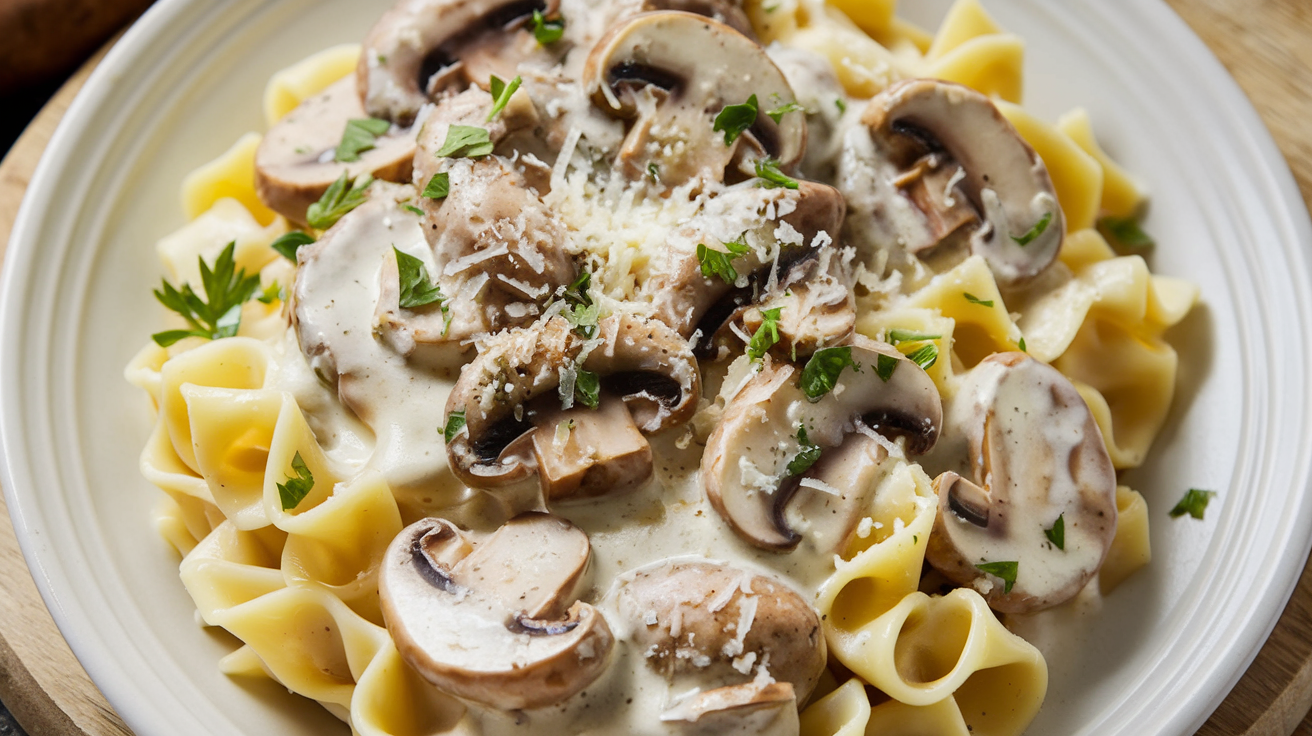
Creamy Mushroom Pasta Recipes That Are Irresistible
Creamy mushroom pasta is a comforting dish that combines rich, earthy flavors with the silkiness of a cream-based sauce. Whether you’re a seasoned cook or just beginning your culinary journey, creamy mushroom pasta is an easy yet indulgent dish that brings a touch of gourmet dining to your home. This article will introduce you to some delicious creamy mushroom pasta recipes that are irresistible, versatile, and perfect for any occasion. So, grab your ingredients and prepare to make a meal that everyone will love!
The Allure of Creamy Mushroom Pasta
Mushrooms are not only packed with nutrients, but they also offer a unique, savory flavor that elevates a dish. When combined with a creamy sauce, the umami notes from the mushrooms blend seamlessly with the richness of cream, butter, and cheese, creating an irresistible flavor profile. Creamy mushroom pasta is versatile and can be tailored to different tastes by adding ingredients like spinach, garlic, or Parmesan. It’s a satisfying dish, ideal for cozy nights in or entertaining guests.
Let’s dive into some delightful creamy mushroom pasta recipes that are sure to impress your family and friends.
Classic Creamy Mushroom Pasta
If you’re looking for a traditional take on creamy mushroom pasta, this classic recipe is the way to go. It’s simple, flavorful, and made with just a few key ingredients.
Ingredients:
- 300g pasta (penne, fettuccine, or spaghetti)
- 250g mushrooms (button, cremini, or a mix of your favorite)
- 2 tbsp olive oil
- 1 tbsp butter
- 2 cloves garlic, minced
- 200ml heavy cream
- 50g Parmesan cheese, grated
- Salt and pepper to taste
- Fresh parsley for garnish
Instructions:
- Cook the pasta in salted boiling water until al dente. Drain and set aside.
- In a large pan, heat olive oil and butter over medium heat. Add the minced garlic and sauté for a minute until fragrant.
- Add the sliced mushrooms to the pan and cook until they become soft and golden brown, about 5-7 minutes.
- Stir in the heavy cream, bring to a gentle simmer, and cook for 3-5 minutes until the sauce thickens.
- Add the Parmesan cheese and stir until melted and combined.
- Season with salt and pepper to taste.
- Toss the cooked pasta into the sauce, ensuring it is fully coated.
- Garnish with fresh parsley and serve hot.
This classic creamy mushroom pasta is incredibly comforting and easy to make. It’s the perfect dish when you’re craving something quick but luxurious.
Creamy Garlic Mushroom Pasta with Spinach
Adding spinach to creamy mushroom pasta not only adds a pop of color but also brings additional nutrients to the dish. The combination of garlic, spinach, and mushrooms creates a well-balanced and hearty meal.
Ingredients:
- 300g fettuccine
- 200g mushrooms, sliced
- 2 cups fresh spinach
- 3 cloves garlic, minced
- 2 tbsp olive oil
- 1 cup heavy cream
- 1/2 cup vegetable broth
- 50g Parmesan cheese, grated
- Salt and pepper to taste
Instructions:
- Cook the fettuccine according to package instructions, drain, and set aside.
- In a large pan, heat the olive oil over medium heat. Add the minced garlic and sauté until golden.
- Add the sliced mushrooms and cook until softened and browned, about 5 minutes.
- Stir in the spinach and cook until wilted.
- Pour in the vegetable broth and heavy cream, bringing the mixture to a simmer.
- Add the Parmesan cheese and stir until melted. Let the sauce thicken for about 2-3 minutes.
- Season with salt and pepper to taste.
- Combine the pasta with the creamy mushroom spinach sauce and toss until well-coated.
- Serve with a sprinkle of Parmesan and enjoy!
This garlic-infused creamy mushroom pasta recipe is perfect for a satisfying dinner, combining the creaminess of the sauce with the fresh taste of spinach.
Vegan Creamy Mushroom Pasta
For those who follow a plant-based diet, creamy mushroom pasta can still be enjoyed! This vegan version is made with dairy-free cream and packed with rich flavors. It’s the ultimate comfort food, without any animal products.
Ingredients:
- 300g pasta (your choice)
- 250g mushrooms (cremini or portobello)
- 2 tbsp olive oil
- 1 onion, finely chopped
- 2 cloves garlic, minced
- 1 cup coconut cream or cashew cream
- 1/4 cup nutritional yeast
- 1 tbsp lemon juice
- Salt and pepper to taste
- Fresh basil for garnish
Instructions:
- Cook the pasta as per package directions, drain, and set aside.
- In a large skillet, heat the olive oil over medium heat and sauté the chopped onions and garlic until soft and translucent.
- Add the mushrooms and cook until golden brown and tender.
- Stir in the coconut cream or cashew cream and bring the mixture to a simmer.
- Add the nutritional yeast, lemon juice, salt, and pepper to the sauce.
- Let the sauce thicken slightly, then toss the cooked pasta into the pan and mix well.
- Garnish with fresh basil and serve.
This vegan creamy mushroom pasta is indulgent and flavorful, proving that you don’t need dairy to create a rich, creamy sauce.
Creamy Mushroom Pasta with Truffle Oil
If you’re looking to elevate your creamy mushroom pasta, truffle oil is the secret ingredient. It adds a luxurious, earthy aroma and takes the dish to gourmet levels.
Ingredients:
- 300g tagliatelle
- 200g mixed mushrooms (shiitake, oyster, and button)
- 2 tbsp olive oil
- 1 shallot, minced
- 1/2 cup heavy cream
- 1 tbsp truffle oil
- 50g Parmesan cheese, grated
- Salt and pepper to taste
- Fresh thyme for garnish
Instructions:
- Cook the tagliatelle in salted water until al dente. Drain and set aside.
- In a large pan, heat the olive oil over medium heat and sauté the minced shallot until softened.
- Add the mixed mushrooms and cook for about 5-7 minutes until they become golden and tender.
- Stir in the heavy cream and allow the sauce to simmer and thicken.
- Remove the pan from the heat and drizzle in the truffle oil. Stir until combined.
- Toss the pasta in the sauce, ensuring each strand is coated.
- Top with Parmesan cheese and fresh thyme before serving.
This creamy mushroom pasta recipe with truffle oil is perfect for a special occasion or a date night at home. The truffle oil enhances the earthy flavor of the mushrooms and adds a touch of luxury to this simple dish.
Frequently Asked Questions
What mushrooms are best for creamy mushroom pasta?
The best mushrooms for creamy mushroom pasta are cremini, button, shiitake, and portobello. You can use a combination of these for added flavor and texture.
Can I make creamy mushroom pasta ahead of time?
Yes, you can make creamy mushroom pasta ahead of time. Prepare the sauce and pasta separately, and combine them just before serving. Reheat the sauce gently on the stove before mixing it with the pasta.
How do I store leftover creamy mushroom pasta?
Leftover creamy mushroom pasta can be stored in an airtight container in the refrigerator for up to three days. When reheating, add a splash of cream or milk to revive the sauce’s texture.
Is creamy mushroom pasta gluten-free?
The pasta itself determines whether the dish is gluten-free. Simply swap out regular pasta for gluten-free pasta, and the rest of the recipe can remain unchanged.
Can I make creamy mushroom pasta without cream?
Yes! You can substitute heavy cream with cashew cream, coconut milk, or even dairy-free alternatives like almond cream for a lighter version of the dish.
What can I serve with creamy mushroom pasta?
Creamy mushroom pasta pairs well with garlic bread, a fresh green salad, or roasted vegetables. These sides help balance out the richness of the pasta.
Conclusion
Creamy mushroom pasta is an incredibly versatile dish that can be adjusted to suit various dietary preferences and flavor profiles. Whether you prefer a classic recipe, a plant-based alternative, or want to add a gourmet touch with truffle oil, these recipes are guaranteed to be a hit. The rich, creamy sauce combined with the earthy flavor of mushrooms creates a pasta dish that is both comforting and indulgent.
For more exciting recipe ideas, visit Foodies Den!
Pasta Recipes
7 Fiery Spicy Pasta Dishes That Heat Seekers Will Love! 🌶️
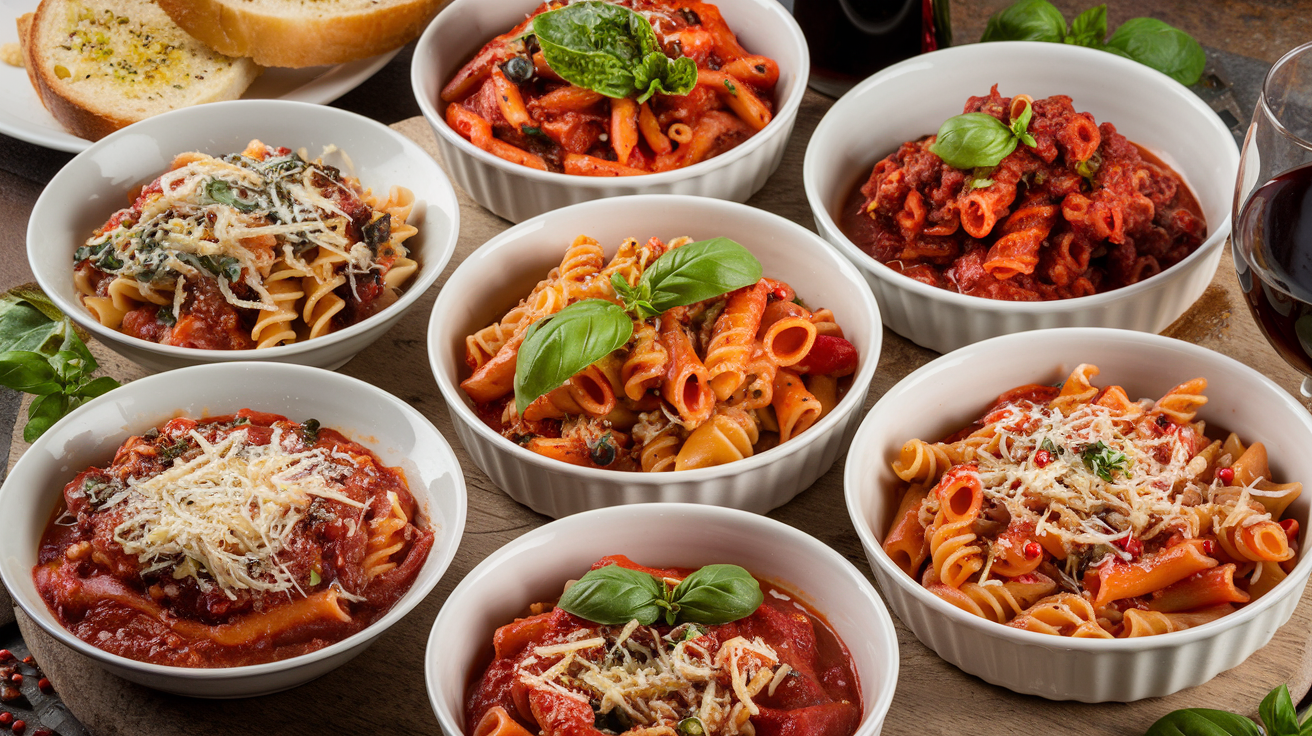
7 Fiery Spicy Pasta Dishes That Heat Seekers Will Love! 🌶️
If you’re a lover of bold flavors and enjoy a good fiery kick in your meals, spicy pasta dishes should be at the top of your list! Combining the comforting textures of pasta with the punch of heat, these dishes deliver a perfect blend of satisfaction and excitement. Whether you’re craving a classic Italian arrabbiata or something with a fusion twist like spicy Thai noodles, these pasta dishes will make you break a sweat in the most delightful way.
Let’s dive into some of the most tantalizing spicy pasta dishes that are sure to ignite your taste buds!
Why Spicy Pasta Dishes Are a Must-Try
Spicy pasta dishes combine the best of both worlds – the warmth and comfort of pasta, paired with the invigorating heat of spices and peppers. Not only do these dishes offer dynamic flavors, but the spice can also bring several health benefits. Capsaicin, the active component in chili peppers, is known to boost metabolism and enhance digestion. Plus, for those who enjoy the endorphin rush from spicy foods, these pasta dishes offer an ideal experience.
But the beauty of spicy pasta is how adaptable it is. Depending on your spice tolerance, you can adjust the heat level by adding more (or less) chili flakes, hot sauces, or spicy sausages. So, whether you’re a daring heat-seeker or just want a bit of a kick, there’s a spicy pasta dish for everyone.
Arrabbiata – The Classic Italian Spicy Pasta Dish
When we talk about spicy pasta dishes, arrabbiata always comes to mind. Originating from the Lazio region of Italy, this dish is made with simple, yet bold ingredients: tomatoes, garlic, and red chili peppers. The name “arrabbiata” translates to “angry” in Italian, reflecting the fiery heat of the sauce.
Ingredients:
- Penne pasta
- Tomatoes (fresh or canned)
- Garlic cloves
- Red chili flakes
- Olive oil
- Fresh basil
The sauce for arrabbiata is quick to prepare, but it’s the red chili peppers that steal the show, adding layers of heat and flavor to the dish. For a more intense kick, opt for crushed red pepper flakes or even fresh hot peppers. Don’t forget to garnish it with a bit of freshly grated Parmesan cheese and basil to balance the heat.
Spicy Cajun Pasta – A Southern Delight
Next on the list of must-try spicy pasta dishes is the crowd-pleasing Cajun pasta. This Southern-inspired dish brings a rich, smoky heat, thanks to the flavorful blend of Cajun spices. It usually includes chicken or shrimp, but you can easily make it vegetarian by adding bell peppers and mushrooms.
Ingredients:
- Fettuccine pasta
- Chicken or shrimp (optional)
- Bell peppers
- Cajun seasoning (a mix of paprika, cayenne, garlic powder, and thyme)
- Cream or milk
The secret to the perfect Cajun pasta lies in its spice mix. Cajun seasoning combines heat with aromatic spices, which create a robust, bold flavor profile. The creamy sauce mellows out the spiciness, making this a balanced yet exciting meal for any heat lover.
Spaghetti Aglio e Olio with Chili
For something simple yet incredibly flavorful, spaghetti aglio e olio with chili is a fantastic choice. This Italian classic usually calls for just olive oil, garlic, and parsley, but to give it that heat-seeker’s twist, adding chili flakes or fresh red chilies is key.
Ingredients:
- Spaghetti
- Olive oil
- Garlic cloves
- Red chili flakes or fresh chilies
- Fresh parsley
- Parmesan cheese (optional)
This dish allows the spicy element to shine, especially if you use fresh chilies. The oil absorbs the heat from the garlic and chili, creating a light yet potent sauce that clings perfectly to the spaghetti. For an added layer of flavor, you can sprinkle a bit of lemon zest on top to cut through the spice.
Spicy Thai Peanut Pasta
If you’re looking to explore global flavors in your spicy pasta dishes, try a spicy Thai peanut pasta. This dish features the unique combination of creamy peanut sauce, lime juice, and red chili paste, offering a rich, spicy, and tangy experience.
Ingredients:
- Rice noodles or linguine
- Peanut butter
- Soy sauce
- Red chili paste
- Lime juice
- Crushed peanuts
- Fresh cilantro
Thai red chili paste brings a fiery element to the dish, which is balanced by the creamy richness of peanut butter. Garnished with cilantro and crushed peanuts, this pasta dish delivers a zesty, spicy, and umami-packed flavor punch that heat seekers will love.
Spicy Pesto Pasta – A Twist on a Classic
For those who love basil pesto but crave a little more excitement, spicy pesto pasta is the perfect way to turn up the heat on this classic dish. By adding jalapeños or red chili flakes to traditional pesto, you can give your pasta a bold and fiery edge.
Ingredients:
- Fusilli or penne pasta
- Basil leaves
- Pine nuts or walnuts
- Olive oil
- Garlic cloves
- Parmesan cheese
- Jalapeños or red chili flakes
The spicy element cuts through the creaminess of the pesto, making each bite refreshing yet spicy. Serve it with grilled chicken or shrimp for a heartier meal, or keep it vegetarian by adding roasted vegetables.
Linguine Fra Diavolo – Devilishly Spicy Seafood Pasta
The name “fra diavolo” means “brother devil,” which already suggests the fiery nature of this spicy pasta dish. Often made with seafood like shrimp or lobster, this dish includes tomatoes, garlic, white wine, and, of course, plenty of red pepper flakes.
Ingredients:
- Linguine pasta
- Shrimp or lobster
- Crushed tomatoes
- White wine
- Garlic cloves
- Red pepper flakes
- Fresh parsley
The red pepper flakes create a punchy sauce that pairs beautifully with the sweetness of the seafood. For an even more intense heat, some cooks add extra fresh chilies. This dish is perfect for heat seekers who love seafood with their spice.
Chipotle Mac and Cheese – A Spicy Comfort Classic
Mac and cheese gets a spicy makeover with the addition of chipotle peppers, creating a creamy yet fiery version of this comfort classic. The smoky heat of chipotle pairs beautifully with the richness of the cheese sauce, making it an ideal dish for anyone who loves both creamy and spicy flavors.
Ingredients:
- Elbow macaroni
- Cheddar cheese
- Cream or milk
- Chipotle peppers in adobo sauce
- Butter
- Garlic powder
The chipotle peppers bring a unique smokiness and a steady burn that intensifies as you eat. If you’re feeling adventurous, you can even top it with crispy jalapeños or hot sauce for an extra kick.
FAQs
What is the best pasta to use for spicy dishes?
The best pasta for spicy dishes often depends on the sauce. Penne or rigatoni is great for thicker sauces like arrabbiata, while spaghetti works well with lighter sauces like aglio e olio.
How can I make my pasta less spicy if it’s too hot?
If you’ve overdone the heat, balance the spice by adding dairy (cream, milk, or cheese), which neutralizes some of the capsaicin, the compound responsible for the heat in chili peppers.
Can I adjust the spiciness in these recipes?
Absolutely! You can always adjust the level of heat by adding more or less chili flakes, hot sauce, or fresh peppers to suit your tolerance.
What can I serve with spicy pasta dishes?
Spicy pasta pairs well with cooling side dishes like a fresh green salad, garlic bread, or even yogurt-based dips like tzatziki to help balance the heat.
Is spicy food healthy?
Spicy foods have health benefits! They can boost metabolism, improve digestion, and even release endorphins, which can enhance your mood.
What’s the best way to store leftovers of spicy pasta dishes?
Store leftovers in an airtight container in the fridge for up to 3 days. The flavors, including the spiciness, often intensify over time!
With these spicy pasta dishes, you can take your taste buds on a thrilling ride! Whether you prefer the bold heat of Cajun pasta or the classic punch of arrabbiata, there’s a dish here for every level of spice lover. Ready to spice up your pasta game? Check out even more fiery recipes and tips at Foodies Den.
-
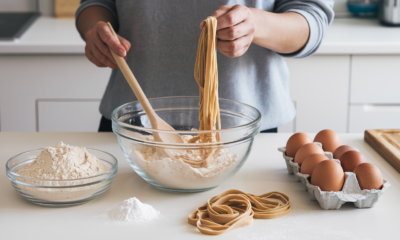
 Pasta Recipes10 months ago
Pasta Recipes10 months agoHow to Make Delicious Gluten Free Pasta at home
-
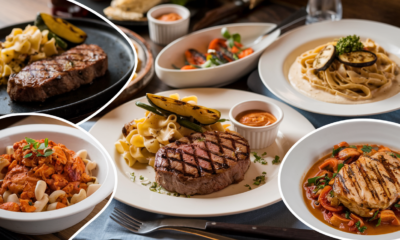
 Pasta Recipes10 months ago
Pasta Recipes10 months ago5 Delicious Steak and Pasta Recipes
-
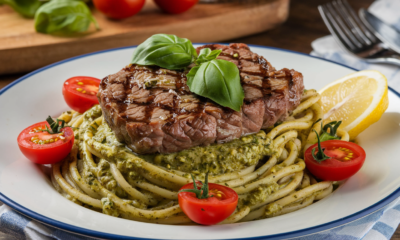
 Pasta Recipes10 months ago
Pasta Recipes10 months agoDelicious & Delightful Steak and Pesto Linguine Recipe
-
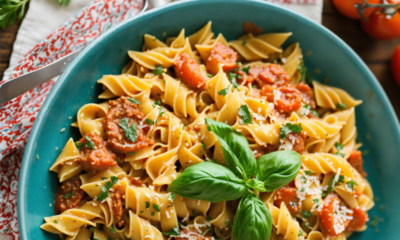
 Pasta Recipes10 months ago
Pasta Recipes10 months agoSwirly Pasta Recipe: Creative, Fun, and Delicious
-

 Pasta Recipes10 months ago
Pasta Recipes10 months agoDelicious & Creamy Steak Alfredo Recipe
-

 Pasta Recipes10 months ago
Pasta Recipes10 months agoBrown Rice Pasta Recipe: A Healthy, Gluten-Free Alternative
-
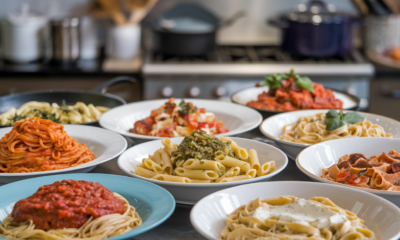
 Pasta Recipes10 months ago
Pasta Recipes10 months ago10 Easy Pasta Recipes for Busy Weeknights
-

 Pasta Recipes10 months ago
Pasta Recipes10 months agoSacchetti Pasta Recipe: Little Pouches of Flavor to Impress






